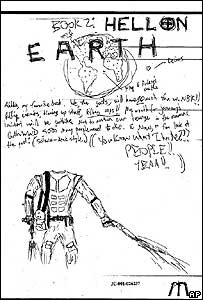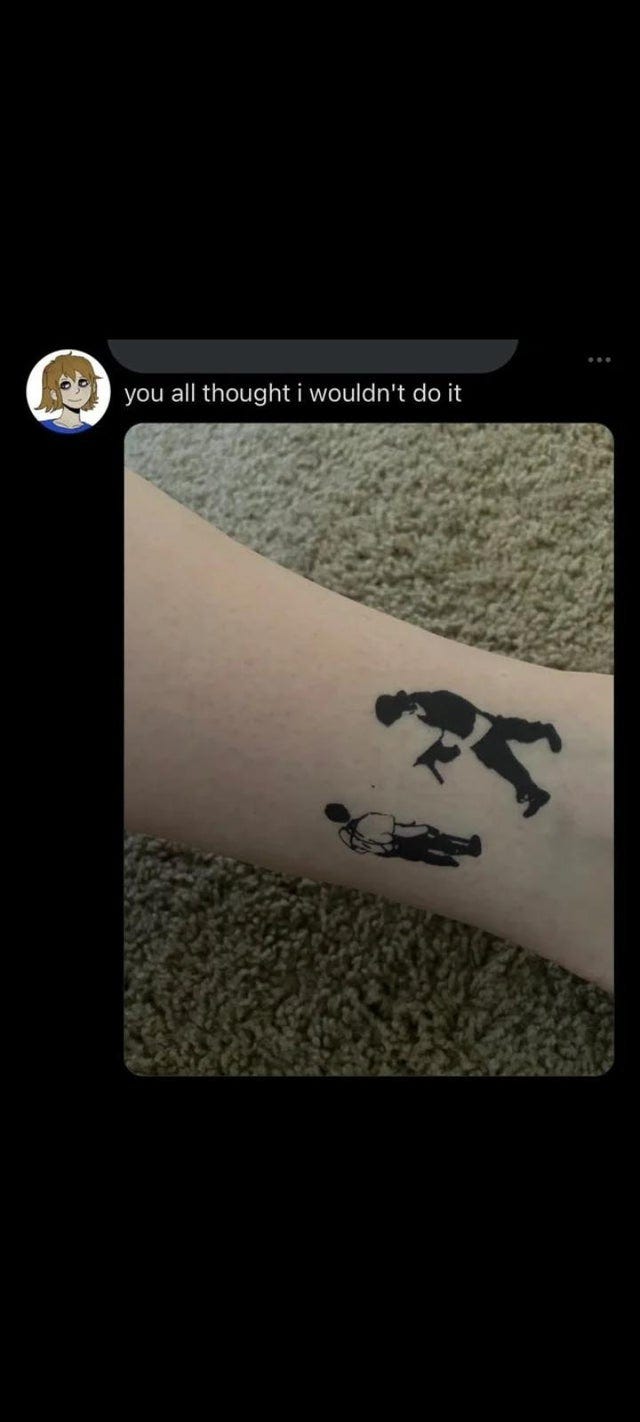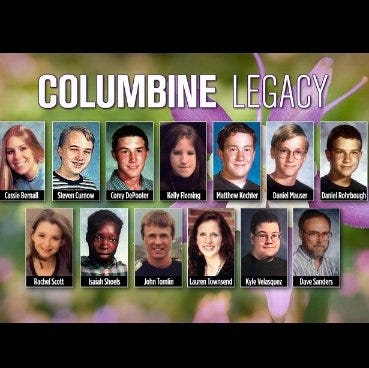‘ Robert’s got a quick hand
He’ll look around the room, but won’t tell you his plan
…
Yeah, he found a six-shooter gun
In his dad’s closet, and with a box of fun things
I don’t even know what
But he’s coming for you, yeah, he’s coming for you’
-Pumped Up Kicks, Foster the People
‘The boys and girls in the clique
The awful names that they stick
You're never gonna fit in much, kid
But if you're troubled and hurt
What you got under your shirt
Will make them pay for the things that they did’
-Teenagers, My Chemical Romance
In the community around school shootings and mass murder, known as the #tcc community, fascination and morbid curiosity, and sometimes genuine empathy morphs easily into condonation, celebration and often romantic desire.
The most infamous school shooting is still Columbine, a shooting which became the aesthetic and ideological influence for a lot of school shootings that took place afterwards. The Columbine shooters wanted to be notorious, they loved making movies, they wanted to be the main characters, they wanted Steven Spielberg to direct the movie about their events. Along with their movies, they left blogs and journals, detailing their feelings, lives and emotions. Talking about aesthetics, even the book publishers have bought into it…
The Columbine shooters cared so much about aesthetics that actually, that’s probably one of the key reasons why this particular shooting has had such an impact on younger people, or the youth. On a Vice video about Columbiner culture, the girl at the centre of it talks about how she just really related to Dylan, how his writings of depression just spoke to her at a time in her life where she was feeling that way. One Youtube comment which I loved pointed out how she made Dylan out as if he was the only teenager ever in the history of the world to experience depression. The truth is that people who relate strongly to the Columbine shooters relate to their feelings of depression, alienation and frustration but they are also attracted to their style and ultimately their use of aesthetic violence. They enjoy the idea of revenge, of taking back power, and to them, the ultimate revenge comes in the form of performance style mass violence. They like the Columbine shooters’ style, the trench coats, the military type weapons, the Tarantino-esque vibe and they like how they seemingly enacted their righteous and just revenge over a society (their school) which supposedly treated them badly. They like how they smoked cigarettes, had an air of rage and non-chalence, a carelessness for life, a desire for dominance and ‘godlike’ control. They relate to their ideas of these boys as being akin to lost puppies, but also their ideas of them as being chilling super evil psychopaths, too intelligent for society, to dangerous, just bigger than life, so dark and mysterious…. etc etc.
The ironic thing is that actually, countering the myths, they weren’t total loners. They had friends, they even went to prom with their friends a few days before…. and as far as I know, going to prom with friends isn’t exactly the most alt-punk-loner thing to do. They were also honour students and were top of their class in computer science. Videos of them before the shooting also show them as shy, kind of dorky, awkward, they fade into the background. One video of Eric shows him just messing at lunch like a normal teenager and being a part of a pretty boring and normal teenage conversation. He wasn’t having deeply intellectual discussions or anything, he was just talking about usual teen shit. Okay, yeah he liked Nietzsche, that’s a bit unique and different, and okay he was smart enough, but his writings aren’t the writings of a prodigy. He admitted to lying and enjoyed lying, he wasn’t very nice and he didn’t have much or any self awareness, for all his intelligence, he didn’t seem to be really using a lot of it.
Plenty of depressed and unstable people will appear happy, and Klebold and Harris’ friends (which they did have) noted that they didn’t know the two guys weren’t happy, I guess they thought they were unconventional and a bit far out, but they didn’t know they were depressed or had issues. Appearances are deceptive, in both ways, these boys weren’t living the life of complete isolation and alienation that copycats and fans believe but they also weren’t in the stable and happy place that their friends believed either. They weren’t the complete and total rejects, they weren’t always being bullied, they had friends, video footage even shows them having fun with their friends, they even some prior girlfriends, they were honour students, they were smart, they had a chance at happiness and a future for themselves. But they broke the wall between fantasy and reality and they killed their future along with the futures of 13 other people and hindering the future of 24 who were injured.
The plan itself also wasn’t framed by the shooters as purely revenge against ‘jocks’, there was a lot going on, including far-right influences such as the Oklahoma City Bombing, which they wanted to ‘beat’ in terms of number of deaths and neo-Nazism (the plan took place on Hitler’s birthday). One of the other ironic parts of the story is how Harris, who had a penchant for Nazism and hated Jewish people, didn’t even know Klebold was half Jewish until it came out by accident in one of the Basement tapes. At that stage, I’m not sure how he felt about Klebold, but it was probably too late for him to change his mind on him, but unfortunately it didn’t quite turn out to be the massive epiphany that could have saved him and everyone else. It could’ve been…. to many it would’ve been…. but no, he was too stubborn to admit he might be wrong even when it was staring him in the face.
All of these nuances and facts get missed by people who decide to relate to them based off of their aesthetics or vibes. It’s easy to sort of put your own story or narrative onto something that visually or emotionally you relate to or like, but in the case of school shooters, a lot of that is sort of buying into certain propaganda that came from the Columbine shooters and the culture that sprang from it. At the same time, the reason songs and movies about school shootings are so popular, especially among teenagers, is because the base feelings of loneliness, depression, suicidality and experiences such as bullying and trauma are just super relatable. The motif of a loner who’s been pushed down until they take out their revenge in a stylistic, aesthetic way against ‘society’, creating notoriety and fame for themselves and becoming folk heroes in the eyes of every next generation of depressed teenagers is attractive and alluring and teenagers will engage with it emotionally.
The idea that school shooters are the only teenagers who ever felt depression ever and who are the only ones who get it and no one else can and ‘stop making this such a big deal, he was depressed and super smart and cool and normies don’t get it and I love him’, is a narrative that seriously needs to end. Sexualising the shooters, making them these dark bad boys or whatever, is toxic, and Columbiners and especially girls in that community are taking part in a form of extremism, in terms of, condoning and celebrating violence as a legitimate response to a grievance and celebrating people who do violence as martyrs.
Buying into the aesthetics of violence created by the Columbine shooters and others like them is only engaging with the influences of nihilism, extremism and ultimately death. The Columbine shooters succeeded in ways where they spread their influence, but they didn’t succeed for themselves; they died, they never had a 19th birthday, they’re gone. The people they killed also died, they also never got to live past school, they didn’t get to experience the world as adults, they didn’t get to grow up, travel, have opportunities, have families and their families lost them, their families lost their children.
While using art, media and other forms of communication in relation to darker feelings and issues is important and actually helpful and cathartic, it’s important to also be aware of the power of the aesthetics especially in relation to violence and real world violence. Just because something can be a cathartic experience for one person does not mean that it won’t be more of an inspiration for another, narratives and aesthetics built up around school shooters may feel a bit like a sort of play into an artform for some, a kind of morbid fascination, maybe even a sort of act of social rebellion, like collecting knives, but for others it could be more encompassing. Understanding the dynamics and the line between fantasy and reality and being able to check that in ourselves, as well as others in a community, like the #tcc community is really important. Noticing when the empathy switches begin to fail in relation to victims of a mass shooting and when interest transcends into obsession, an especially when weapons are being accumulated and pictures of these weapons are shared are all warning signs.
Also being aware that it’s not just mass shootings that are a potential, but suicide too. At the same time, people have to be honest to themselves about their interest or fascination into school and mass shootings, it may not be simply an ‘interest in the aesthetic’ and also regardless of the fascination it might have for some people, hyping it up, being active in a culture around it, only serves to dehumanise the victims and potentially inspire others who are looking for the emotional reactions that (especially) girls in these communities show towards these individuals. Tangential support for violence, even if they claim they don’t condone it, is still support for violence.
The irony is that for every Eric Harris and Dylan Klebold, there are so many kids who are going through this or went through this and aren’t going to commit any violence, who would never do that, but they’re being denied the same kind of empathy and treatment. If a normal 16 year old who didn’t perpetrate any violence published his diary online, would anyone read it? Maybe they should… maybe we should be working on making that more of the vibe, instead of obsessing over the ones who are now gone or facing serious prison time. Maybe we should start caring like for this for those who aren’t too far gone, who haven’t crossed that line, because they’re here with us now, and they deserve our empathy too.
We always need to be able to differentiate between aesthetics and reality and to never exchange empathy for a fantasy.










